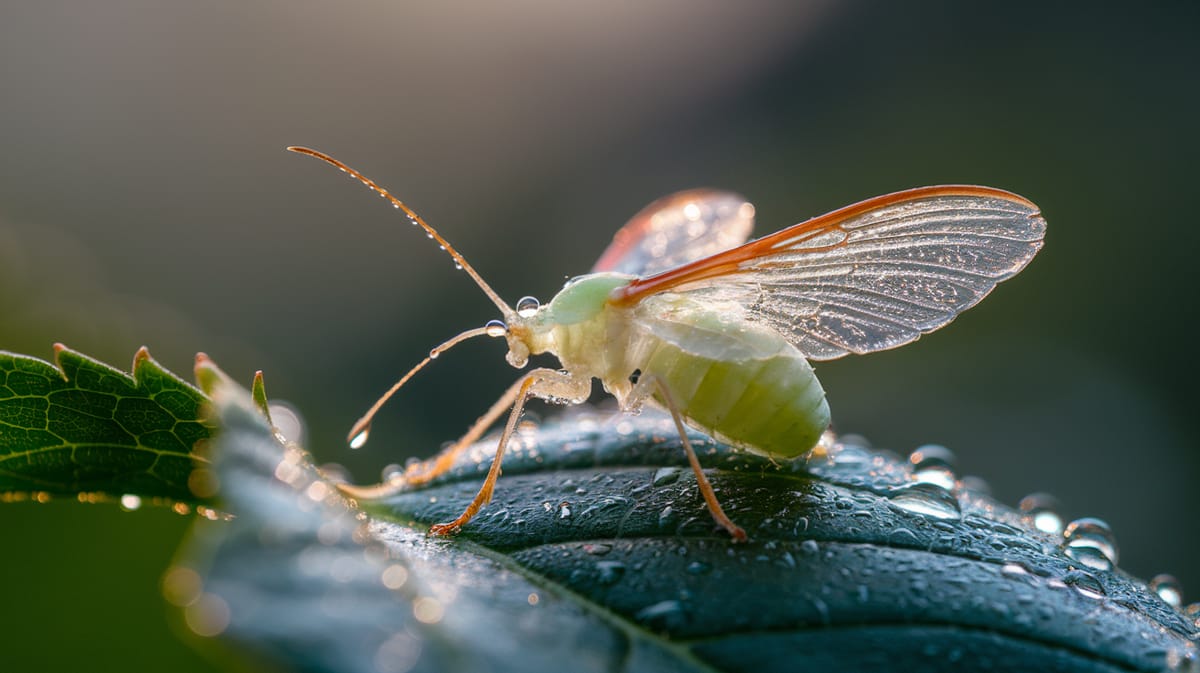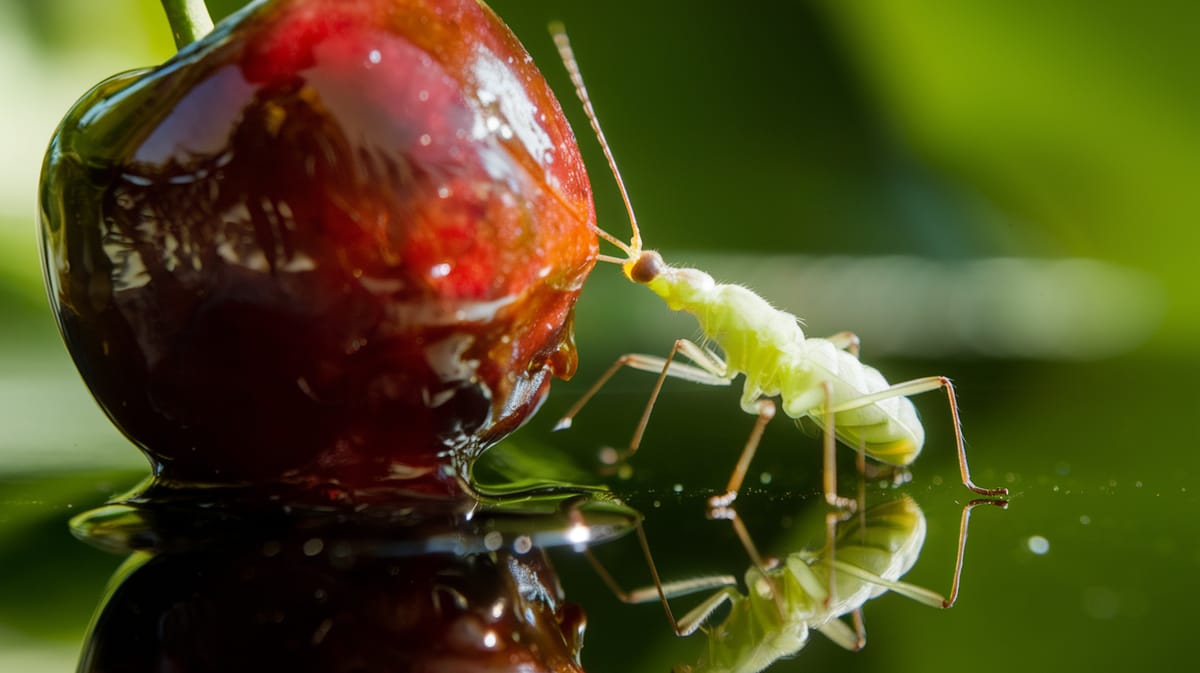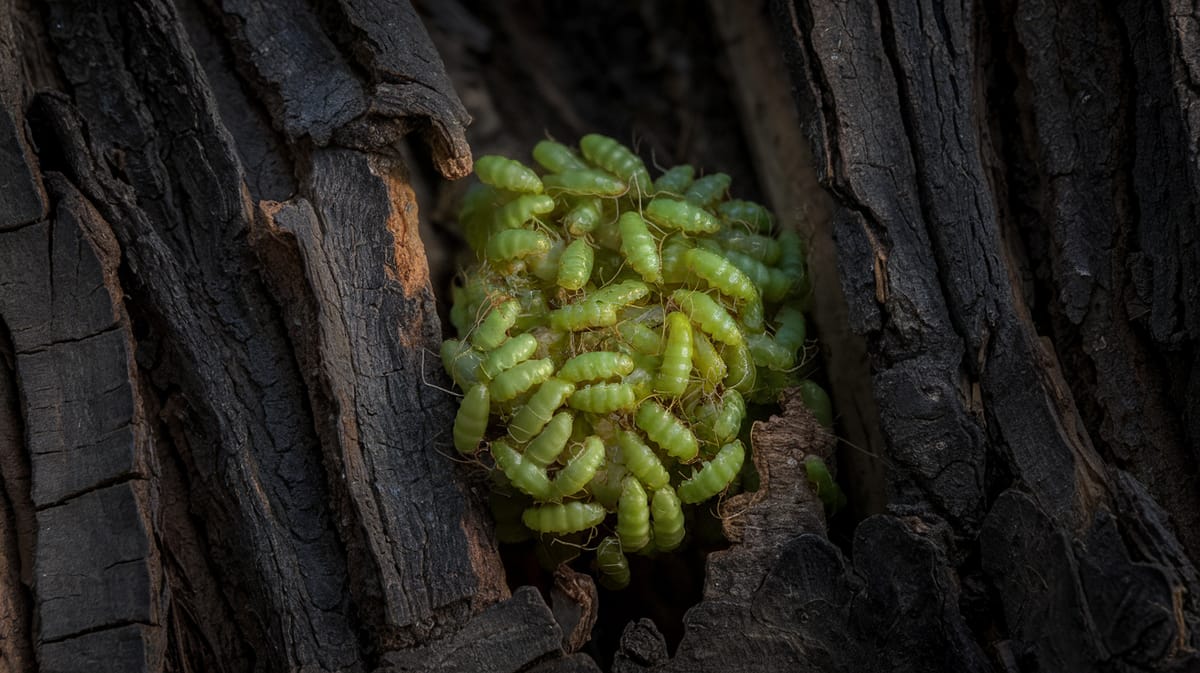Cherry Aphid
Glossy black and abundant on cherry leaves, the Cherry Aphid showcases its talent for rapid reproduction. Its sugary excretions support ant populations, forming a unique symbiotic relationship.

Key Insights at a Glance
Did You Know?
Taxonomy & Classification
The Cherry Aphid, Myzus cerasi, exhibits unique adaptations like rapid reproduction and sap-sucking capabilities, making it a prolific pest of cherry trees. Let's understand the evolutionary journey and classification of these remarkable herbivores.
Global Presence
Found across Europe, Asia, and North America, the Cherry Aphid thrives in diverse terrestrial ecosystems, impacting cherry cultivation globally.
Evolutionary Adaptations
Evolving from ancient sap-feeding ancestors, Cherry Aphids have developed specialized mouthparts and symbiotic relationships with ants for protection and survival.
Lifecycle and Growth
A remarkable journey of transformation from Egg to Adult.
Egg
Laid on cherry trees, these eggs overwinter, waiting for spring warmth to trigger hatching into nymphs.
Nymph
Nymphs molt through five stages, growing rapidly and feeding on plant sap to develop into adults.
Adult
Adults reproduce quickly, often giving live birth to nymphs, contributing to swift population increase.
Dietary Habits
A specialized feeder with a keen focus on plant sap, it adapts efficiently to various host plants in its environment.
| DIET TYPE | DESCRIPTION |
|---|---|
| Primary Diet | Primarily consumes phloem sap from cherry trees, using its piercing mouthparts to extract nutrients. |
| Secondary Diet | Occasionally feeds on sap from other fruit trees like plum and peach, supplementing its primary diet. |
| Occasional | Rarely taps into moisture from tender leaves or stems during drought or scarcity of preferred hosts. |

Behaviour and Adaptations
Discover the fascinating adaptations that allow the Cherry Aphid to thrive on cherry trees.
Rapid Reproduction
Cherry Aphids reproduce quickly, ensuring population growth and survival.
Host Plant Specialization
They are finely tuned to feed on cherry tree sap, maximizing nutrient intake.
Ant-Aphid Mutualism
Ants protect aphids in exchange for honeydew, benefiting both species.
Ecosystem Impact
The Cherry Aphid plays a crucial role in ecological balance through its interactions and contributions.
Nutrient Recycler
Facilitates nutrient cycling by breaking down plant material for soil enrichment.
Food Source
Serves as a primary food source for various predators, supporting biodiversity.
Pollination Aid
Indirectly aids pollination by attracting pollinators to aphid-infested plants.
Conservation Challenges
Understanding and addressing the major threats to Cherry Aphid populations.
Chemical Exposure
Pesticides disrupt Cherry Aphid life cycles and habitats.
Habitat Destruction
Urbanization reduces cherry aphid habitats, threatening their survival.
Climate Change
Temperature fluctuations impact Cherry Aphid reproduction and distribution.
Frequently Asked Questions
How long do Cherry Aphid live?
Cherry aphids typically have a lifespan of about 20 to 40 days. This can vary depending on environmental conditions such as temperature and availability of food. They reproduce rapidly, allowing their population to grow quickly, especially during favorable weather conditions.
What do Cherry Aphid eat?
Cherry aphids primarily feed on the sap of cherry trees. They use their piercing mouthparts to extract the sugary fluid from plant tissues. This feeding can lead to distorted leaves and weakened plants, making them a significant pest for cherry growers.
Are Cherry Aphid poisonous?
Cherry aphids are not poisonous to humans or animals. However, they can cause damage to plants by transmitting viruses and promoting the growth of sooty mold with their honeydew secretion, which can affect plant health and yield.
Are Cherry Aphid endangered?
Cherry aphids are not considered endangered. They are common agricultural pests found in many regions where cherry trees are grown. Their populations are generally well-managed by natural predators and pest control measures used in agricultural practices.
What do Cherry Aphid symbolize?
In some cultures, aphids, including cherry aphids, might symbolize vulnerability or small annoyances due to their pest status. They can also represent resilience and adaptability given their rapid reproductive cycle and ability to thrive in various conditions.
Do Cherry Aphid bite?
Cherry aphids do not bite humans or animals. Their mouthparts are adapted for piercing plant tissues to feed on sap rather than causing harm to larger organisms. Their presence is primarily a concern for plants rather than people or pets.
What color are Cherry Aphid?
Cherry aphids are typically black or dark brown, but some may appear green, especially during different growth stages. Their color can vary slightly based on environmental factors and the specific species or variety of aphid.
Does a Cherry Aphid have wings?
Some adult cherry aphids develop wings, especially when their population becomes crowded or food sources are depleted. These winged forms can migrate to new plants to establish colonies. Wingless forms are more common when conditions are stable.
What does a Cherry Aphid look like?
Cherry aphids are small, soft-bodied insects, usually less than 2 millimeters long. They have a pear-shaped body, long antennae, and may be winged or wingless. Their coloration ranges from black to dark brown, and they often cluster in groups on leaves and stems.
Is a Cherry Aphid an insect?
Yes, a cherry aphid is an insect. It belongs to the order Hemiptera, which includes true bugs. Like other insects, aphids have three main body parts: the head, thorax, and abdomen, along with six legs, distinguishing them as typical insects.
Related Insects
Discover insects with similar characteristics to Cherry Aphid - including shared habitats, diets, and taxonomic classifications
Share this profile
Help others discover Cherry Aphid
